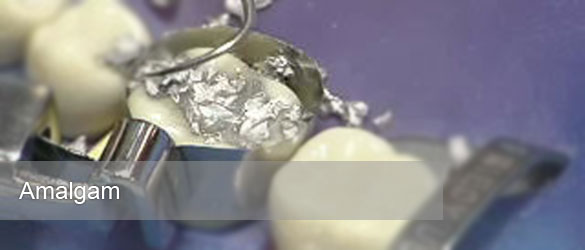 Amalgam
Amalgam
What Is Amalgam?
(Read more at www.ada.org)
Amalgam is a mixture of mainly silver, tin, copper and mercury. Dental Amalgam is the most frequently used filling material because it is strong and durable and it has been used for more than a century with good results.
Amalgam Fillings. How Safe Is It? An Overview.
Amalgam has been used to restore the teeth of more than 100 million Americans. However, the fact that its formulation includes mercury content has raised safety concerns in the minds of some. Small amounts of mercury vapor can be released from amalgam during placement, mastication and brushing. The safety of dental amalgam has been studied and reviewed extensively and no correlation has been found between the small amounts of mercury released from amalgam restorations and any adverse health effect.
1. Life Sciences Research Office Literature Review.
In 2004, an expert panel reviewed the peer-reviewed, scientific literature published from 1996 to December 2003 on potential adverse human health effects caused by dental amalgam and published a report. The review was conducted by the Life Sciences Research Office (LSRO) and funded by the National Institutes of Dental and Craniofacial Research, National Institutes of Health and the Centers for Devices and Radiological Health, U.S. Food and Drug Administration (FDA). The resulting report states that, ai???The current data are insufficient to support an association between mercury release from dental amalgam and the various complaints that have been attributed to this restoration material. Individuals with dental amalgam-attributed complaints had neither elevated urinary mercury nor increased prevalence of hypersensitivity to dental amalgam or mercury when compared with controls.ai???
2. FDA Literature Review (White Paper).
In 1997, the U.S. Food and Drug Administration (FDA) and U.S. Public Health Service concluded from a review of nearly 60 peer-reviewed studies that the ai???data does not support claims that individuals with dental amalgam restorations will experience adverse effects, including neurologic, renal or developmental effects, except for rare allergic or hypersensitivity reactions.ai??? Recently the FDA set out again to update its position on dental amalgam based upon the literature that has been published since the 1997 review. In 2009 they concluded ai???that there is insufficient evidence to support an association between exposure to mercury from dental amalgams and adverse health effects in humans, including sensitive subpopulations.ai???According to the 1995 FDI/WHO consensus statement, components in dental restorative materials, including Amalgam, may in rare instances, result in local side effects or allergic reactions. There is no scientific literature to indicate that the use of Dental Amalgam is detrimental to health and replacement of Amalgam fillings is not indicated.
The WHO threshold limit value for mercury vapour is 300-500 ug per day. A Swedish Dentist discovered in his research that the measurement of the average daily dose of mercury vapour inhaled from Amalgam restorations was only 1.7ug. This is only 1% of the threshold limit value recommended by WHO. There are a number of sources that contribute to the amount of mercury in our system. In fact, the consumption of fish in our diet has a higher contribution to the body burden of mercury than Amalgam restorations. In comparison, the amount of mercury vapour released from Amalgam restorations is minimal!
Based on the results of a comprehensive literature review on amalgam safety, the ADA Council on Scientific Affairs (CSA) reaffirmed that the scientific evidence supports the ADAai??i??s position that amalgam is a valuable, viable and safe choice for dental patients.
